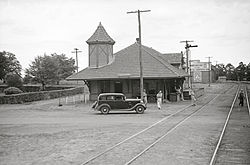This article includes a list of general
references, but it lacks sufficient corresponding
inline citations. (August 2015) |
 | |
 The railroad's
Byromville, Georgia station in 1938 | |
| Overview | |
|---|---|
| Headquarters | Atlanta, Georgia, U.S. |
| Reporting mark | AB&C |
| Locale |
Alabama Georgia |
| Dates of operation | 1887–1945 |
| Successor | Atlantic Coast Line Railroad |
| Technical | |
| Track gauge | 4 ft 8+1⁄2 in (1,435 mm) standard gauge |
| Length | 640 miles (1,030 kilometres) |
The Atlanta, Birmingham and Coast Railroad was organized in 1926 to replace the bankrupt Atlanta, Birmingham and Atlantic Railway. The AB&C was controlled by the Atlantic Coast Line Railroad, which owned a majority of the stock. In 1944 it reported 763 million net ton-miles of revenue freight and 33 million passenger-miles; at the end of that year it operated 639 miles of road and 836 miles of track (the main trackage plus all sidings, spurs, terminal tracks, and shared tracks).
Passenger services
The AB&C operated daily freight and passenger trains between its northern endpoints, Atlanta and Birmingham, and its southern ones, Brunswick, Waycross, and Thomasville. Passenger trains from Atlanta used Terminal Station until November 1933, when the AB&C moved to Atlanta Union Station. [1] Other southbound trains left Birmingham from the AB&C's own Eleventh Street station there. [2] The two northern branches joined at Manchester to form a single main line to the port city of Brunswick, on the Atlantic coast.
A branch from the main line at Fitzgerald ran 80 miles southwesterly to Thomasville, while another branch carried trains to Waycross for connection with the Atlantic Coast Line to the Florida railroad hub of Jacksonville, 75 miles away. [3]
From January 1936, the AB&C was a link in the route of the Chicago-Miami Dixieland. which ran in the winter season only, carrying coaches and Pullmans between Atlanta and Waycross. [4] And beginning in January 1940, the AB&C also carried the Dixie Flagler, a new, streamlined all-coach train that ran every third day, one of a trio of streamliners that provided daily service between Chicago and Miami via multiple railroads over three different routes. The route via the AB&C was the shortest of all three, a total of 1455 miles, covered in 29 1/2 hours. [5]
Acquisition
In 1946 the AB&C was merged into the ACL, becoming the latter company's Western Division.
References
-
^ Storey, Steve.
"Atlanta Terminal Station". Georgia's Railroad History and Heriitage. Archived from the original on 29 April 2018. Retrieved 30 April 2023.
{{ cite web}}: CS1 maint: bot: original URL status unknown ( link) - ^ "Index of Railroad Stations, 1484". Official Guide of the Railways. 64 (9). National Railway Publication Company. February 1932.
- ^ "Atlanta, Birmingham and Coast Railroad, Tables 1, 2, 3, 4". Official Guide of the Railways. 64 (9). National Railway Publication Company. February 1932.
- ^ Prince, Richard E. (1967). The Nashville, Chattanooga & St. Louis Railway: History and Steam Locomotives. Bloomington: Indiana University Press [reprint, 2001]. p. 156. ISBN 0253339278. Retrieved 27 April 2023.
- ^ Bowen, Eric H. "The Dixie Flagler - June, 1941". Streamliner Schedules. Retrieved 27 April 2023.
Bibliography
- Goolsby, Larry. Atlantic, Birmingham & Coast. ACL&SAL Historical Society. 2000.
- Storey, Steve; Ray, David; McDaniel, Matt (November 2018). Historic Railroads of Georgia: A Historic Context Study and Evaluation of Georgia's Historic Railroads Appendix A: Atlanta, Birmingham & Coast Railroad (PDF) (Report). Archived (PDF) from the original on February 21, 2022. Retrieved February 21, 2022.
External links
- Atlanta, Birmingham and Coast Railroad - report by Georgia Department of Transportation, 2018; 54 pp.
- Georgia Railroads, History and Heritage - includes system map
- Defunct Georgia (U.S. state) railroads
- Former Class I railroads in the United States
- Predecessors of the Atlantic Coast Line Railroad
- Railway companies established in 1926
- Railway companies disestablished in 1946
- Defunct Alabama railroads
- American companies established in 1926
- 1946 mergers and acquisitions
- 1926 establishments in Georgia (U.S. state)
- 1946 disestablishments in Georgia (U.S. state)
- American companies disestablished in 1946
- United States Class I railroad stubs